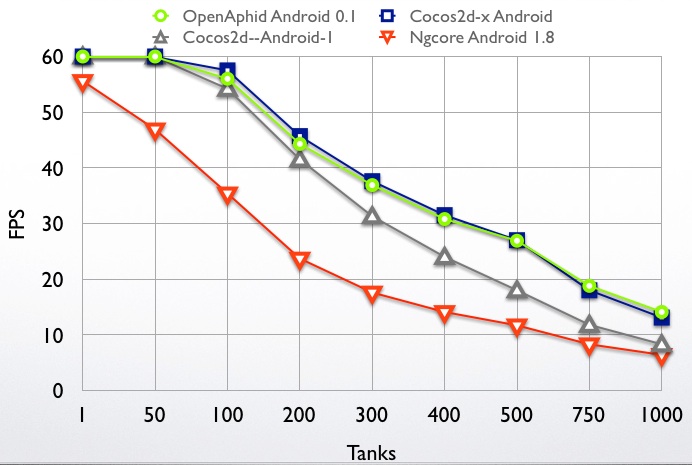We’re excited to release the first version of OpenAphid-Engine which supports Android OS. OpenAphid-Engine is now a cross platform 2D game engine with both iOS and Android support.
Several github repositories have been updated, please check them out for more details:
-
https://github.com/openaphid/Runtime is updated with the Android related codes. You can check it out and build it with Android NDK.
-
https://github.com/openaphid/Demos is also refreshed with the Android project files. You can download the prebuilt APK files to test them on your Android devices: OpenAphid-Android-Demos.apk
Highlights and Limitations of OpenAphid-Engine Android v0.1
It’s the beginning of cross platform support of OpenAphid-Engine. Please consider it as an alpha release. But we’d like to summarize some implementation highlights here:
-
The core runtime shares the same code base with the iOS version, which makes new features can be added to both platforms in the future.
-
The same JavaScript engine is used on both platforms, which saves us from building a proxy layer to support different engines on different platforms as other solutions do. It also brings better performance which we’ll prove later.
-
The project is built with the standard Android NDK, no private or undocumented APIs are used.
This release is lack of several important features comparing to the iOS version. We’re planning another release to make it catch up in the near future.
-
The native library is built for
armeabi-v7aonly in this release.armeabisupport will be included in the next release. -
JavaScript JIT compileris not enabled. We’ve done some experiments to enable it on Android OS, which shows promising performance gains for computation intensive tasks and regular expressions. But we decided to disable it now as we didn’t spend enough time on evaluating its stability. -
JavaScript to Dalvik Java bindingis not implemented.XMLHttpRequestandmultitouchsupports are absent too. -
This version doesn’t reload textures automatically when the GL context is destroyed. It simply finishes the activity if GL context is lost. We’re working on a better way to handle it.
Performance Benchmark
The same tank program as introduced in our previous post is used to evaluate the performance of OpenAphid-Engine on Android OS. Several other Android 2D game engines are chose as references:
-
cocos2d-x 1.0.1-0.13.0, a C++ port of
cocos2d-iphonewhich supports Android OS. -
cocos2d-android-1, another port of
cocos2d-iphonewhich is implemented in pure Java. -
Ngcore 1.8, a commercial game engine from DeNA which also uses JavaScript and OpenGL ES.
The benchmark is performed on a Motorola DEFY+ MB526 phone, which has a 1GHz processor and a 854x480 sized screen. Its Android OS version is 2.3.6.
We captured the average FPS in 5 seconds for displaying different number of tanks with each engine:

OpenAphid-Engine shows great performance again as we can tell from this chart. It’s on par with cocos2d-x, and faster than others.
cocos2d-android-1 suffers from the frequently GC pauses of Dalvik VM as observed from logcat. Ngcore is the slowest engine once again, and its rendering is also buggy in this test. The dirty area in black color should have been cleared in the screenshot below, we’ve filed a bug report about it to Ngcore:

About the Next Release
The next release will make the Android version have all features as the iOS version does. JavaScript to Dalvik Java binding APIs will be introduced to make integrating 3rd-party services become cross platform too. We’ll add new features simultaneously on both iOS and Android versions after that release.
Stay Tuned!